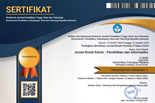DECISION TREE C4.5 ALGORITHM FOR TUITION AID GRANT PROGRAM CLASSIFICATION (CASE STUDY: DEPARTMENT OF INFORMATION SYSTEM, UNIVERSITAS TEKNOKRAT INDONESIA)
Abstract
Full Text:
PDFReferences
A. K. Hamoud, A. S. Hashim, and W. A. Awadh, “Predicting Student Performance in Higher Education Institutions Using Decision Tree Analysis,” Int. J. Interact. Multimed. Artif. Intell., vol. 5, no. 2, p. 26, 2018, doi: 10.9781/ijimai.2018.02.004.
A. Petropoulos, V. Siakoulis, E. Stavroulakis, and A. Klamargias, “A robust machine learning approach for credit risk analysis of large loan level datasets using deep learning and extreme gradient boosting,” use big data Anal. Artif. Intell. Cent. Bank., vol. 50, no. August, pp. 30–31, 2018, [Online]. Available: https://www.bis.org/ifc/publ/ifcb49_49.pdf.
B. Chermiti, “Establishing risk and targeting profiles using data mining: Decision trees,” World Cust. J., vol. 13, no. 2, pp. 39–58, 2019.
H. Patel and P. Prajapati, “Study and Analysis of Decision Tree Based Classification Algorithms,” Int. J. Comput. Sci. Eng., vol. 6, no. 10, pp. 74–78, 2018, doi: 10.26438/ijcse/v6i10.7478.
H. Sharma and S. Kumar, “A Survey on Decision Tree Algorithms of Classification in Data Mining,” Int. J. Sci. Res., vol. 5, no. 4, pp. 2094–2097, 2016, doi: 10.21275/v5i4.nov162954.
J. Mesarić and D. Šebalj, “Decision trees for predicting the academic success of students,” Croat. Oper. Res. Rev., vol. 7, no. 2, pp. 367–388, 2016, doi: 10.17535/crorr.2016.0025.
K. Mittal, D. Khanduja, and P. Tewari, “An Insight into ‘Decision Tree Analysis,’” Int. J. Peer Rev. J. Ref. J. Index. J. UGC Approv. J. Impact Factor, vol. 3, no. 12, pp. 111–115, 2017, [Online]. Available: www.wwjmrd.com.
M. A. Al-Barrak and M. Al-Razgan, “Predicting Students Final GPA Using Decision Trees: A Case Study,” Int. J. Inf. Educ. Technol., vol. 6, no. 7, pp. 528–533, 2016, doi: 10.7763/ijiet.2016.v6.745.
M. Nowak, “Defining Project Approach using Decision Tree and Quasi-hierarchical Multiple Criteria Method,” Procedia Eng., vol. 172, pp. 791–799, 2017, doi: 10.1016/j.proeng.2017.02.125.
M. Tsami, G. Adamos, E. Nathanail, E. Budilovich, I. Yatskiv, and V. Magginas, “A decision tree approach for achieving high customer satisfaction at urban interchanges,” Transp. Telecommun., vol. 19, no. 3, pp. 194–202, 2018, doi: 10.2478/ttj-2018-0016.
R. H. A. Alsagheer, A. F. H. Alharan, and A. S. A. Al-Haboobi, “Popular Decision Tree Algorithms of Data Mining Techniques: A Review,” Int. J. Comput. Sci. Mob. Comput., vol. 6, no. 6, pp. 133–142, 2017.
Rismayanti, “Decision Tree Penentuan Masa Studi Mahasiswa Prodi Teknik Informatika (Studi Kasus : Fakultas Teknik dan Komputer Universitas Harapan Medan ),” J. Sist. Inf., vol. 02, no. 01, pp. 16–24, 2018.
S. Ben Jabeur, A. Sadaaoui, A. Sghaier, and R. Aloui, “Machine learning models and cost-sensitive decision trees for bond rating prediction,” J. Oper. Res. Soc., vol. 71, no. 8, pp. 1161–1179, 2020, doi: 10.1080/01605682.2019.1581405.
S. Bekesiene and S. Hoskova-Mayerova, “Decision tree-Based classification model for identification of effective leadership indicators,” J. Math. Fundam. Sci., vol. 50, no. 2, pp. 121–141, 2018, doi: 10.5614/j.math.fund.sci.2018.50.2.2.
DOI: https://doi.org/10.21107/edutic.v7i1.8849
Refbacks
- There are currently no refbacks.
Copyright (c) 2020 Ahmad Ari Aldino, Heni Sulistiani

This work is licensed under a Creative Commons Attribution 4.0 International License.
Indexed by:
 J. Ilm. Edutic is licensed under a Creative Commons Attribution 4.0 International License.
J. Ilm. Edutic is licensed under a Creative Commons Attribution 4.0 International License.















